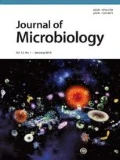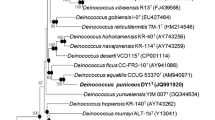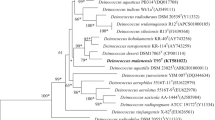Abstract
Strain DY59T, a Gram-positive non-motile bacterium, was isolated from soil in South Korea, and was characterized to determine its taxonomic position. Phylogenetic analysis based on the 16S rRNA gene sequence of strain DY59T revealed that the strain DY59T belonged to the family Deinococcaceae in the class Deinococci. The highest degree of sequence similarities of strain DY59T were found with Deinococcus radiopugnans KACC 11999T (99.0%), Deinococcus marmoris KACC 12218T (97.9%), Deinococcus saxicola KACC 12240T (97.0%), Deinococcus aerolatus KACC 12745T (96.2%), and Deinococcus frigens KACC 12220T (96.1%). Chemotaxonomic data revealed that the predominant fatty acids were iso-C15:0 (19.0%), C16:1 ω7c (17.7%), C15:1 ω6c (12.6%), iso-C17:0 (10.3%), and iso-C17:1 ω9c (10.3%). A complex polar lipid profile consisted of a major unknown phosphoglycolipid. The predominant respiratory quinone is MK-8. The cell wall peptidoglycan contained D-alanine, L-glutamic acid, glycine, and L-ornithine (di-amino acid). The novel strain showed resistance to gamma radiation, with a D10 value (i.e. the dose required to reduce the bacterial population by 10-fold) in excess of 5 kGy. Based on the phylogenetic, chemotaxonomic, and phenotypic data, strain DY59T (=KCTC 33033T =JCM 18581T) should be classified as a type strain of a novel species, for which the name Deinococcus swuensis sp. nov. is proposed.
Similar content being viewed by others
References
Brooks, B.W. and Murray, R.G.E. 1981. Nomenclature for “Micrococcus radiodurans” and other radiation-resistant cocci: Deinococcaceae fam. nov. and Deinococcus gen. nov., including five species. Int. J. Syst. Bacteriol.19, 353–360.
Brown, A.E. 2008. Benson’s microbiological applications: laboratory manual in general microbiology, complete version, 10th Edition. McGraw-Hill.
Collins, M.D. and Jones, D. 1981. Distribution of isoprenoid quinone structural types in bacteria and their taxonomic implications. Microbiol. Rev.45, 316–354.
Ezaki, T., Hashimoto, Y., and Yabuuchi, E. 1989. Fluorometric deoxyribonucleic acid-deoxyribonucleic acid hybridization in microdilution wells as an alternative to membrane filter hybridization in which radioisotopes are used to determine genetic relatedness among bacterial strains. Int. J. Syst. Bacteriol.39, 224–229.
Felsenstein, J. 1985. Confidence limit on phylogenies: an approach using the bootstrap. Evolution39, 783–791.
Ferreira, A.C., Nobre, M.F., Rainey, F.A., Silva, T.M.T., Wait, R., Burghardt, J., Chung, A.P., and Costa, M.S.D. 1997. Deinococcus geothermalis sp. nov. and Deinococcus murrayi sp. nov., two extremely radiation-resistant and slightly thermophilic species from hot springs. Int. J. Syst. Bacteriol.47, 939–947.
Gerhardt, P., Murray, R.G.E., Wood, W.A., and Krieg, N.R. 1994. Methods for General and Molecular Bacteriology. American Society for Microbiology, Washington, D.C., USA.
Hall, T.A. 1999. BioEdit: a user-friendly biological sequence alignment editor and analysis program for Windows 95/98/NT. Nucleic Acids Symp. Ser.41, 95–98.
Hirsch, P., Gallikowski, C.A., Siebert, J., Peissl, K., Kroppenstedt, R., Schumann, P., Stackebrandt, E., and Anderson, R. 2004. Deinococcus frigens sp. nov., Deinococcus saxicola sp. nov., and Deinococcus marmoris sp. nov., low temperature and draught-tolerating, UV-resistant bacteria from continental Antarctica. Syst. Appl. Microbiol.27, 636–645.
Im, W.-T., Jung, H.-M., Ten, L.N., Kim, M.K., Bora, N., Goodfellow, M., Lim, S., Jung, J., and Lee, S.-T. 2008. Deinococcus aquaticus sp. nov., isolated from fresh water, and Deinococcus caeni sp. nov., isolated from activated sludge. Int. J. Syst. Evol. Microbiol.58, 2348–2353.
Kämpfer, P., Lodders, N., Huber, B., Falsen, E., and Busse, H.-J. 2008. Deinococcus aquatilis sp. nov., isolated from water. Int. J. Syst. Evol. Microbiol.58, 2803–2806.
Kim, O.-S., Cho, Y.-J., Lee, K., Yoon, S.-H., Kim, M., Na, H., Park, S.-C., Jeon, Y.S., Lee, J.-H., Yi, H., Won, S., and Chun, J. 2012. Introducing EzTaxon-e: a prokaryotic 16S rRNA gene sequence database with phylotypes that represent uncultured species. Int. J. Syst. Evol. Microbiol.62, 716–721.
Kimura, M. 1983. The neutral theory of molecular evolution. Cambridge: Cambridge University Press.
Komagata, K. and Suzuki, K. 1987. Lipid and cell-wall analysis in bacterial systematics. Methods Microbiol.19, 161–207.
Lai, W.-A., Kämpfer, P., Arun, A.B., Shen, F.-T., Huber, B., Rekha, P.D., and Young, C.-C. 2006. Deinococcus ficus sp. nov., isolated from the rhizosphere of Ficus religiosa L. Int. J. Syst. Evol. Microbiol.56, 787–791.
Lim, S., Song, D., Joe, M., and Kim, D. 2012. Development of a qualitative dose indicator for gamma radiation using lyophilized Deinococcus. J. Microbiol. Biotechnol.22, 1296–1300.
Lim, S., Yoon, H., Ryu, S., Jung, J., Lee, M., and Kim, D. 2006. A comparative evaluation of radiation-induced DNA damage using real-time PCR: influence of base composition. Radiat. Res.165, 430–437.
Mesbah, M., Premachandran, U., and Whitman, W.B. 1989. Precise measurement of the G+C content of deoxyribonucleic acid by high-performance liquid chromatography. Int. J. Syst. Bacteriol.39, 159–167.
Minnikin, D.E., O’Donnell, A.G., Goodfellow, M., Alderson, G., Athalye, M., Schaal, A., and Parlett, J.H. 1984. An integrated procedure for the extraction of bacterial isoprenoid quinones and polar lipids. J. Microbiol. Methods2, 233–241.
Oyaizu, H., Stackebrandt, E., Schleifer, K.H., Ludwig, W., Pohla, H., Ito, H., Hirata, A., Oyaizu, Y., and Komagata, K. 1987. A radiation-resistant rod-shaped bacterium, Deinobacter grandis gen. nov., sp. nov., with peptidoglycan containing ornithine. Int. J. Syst. Bacteriol.37, 62–67.
Rainey, F.A., Ray, K., Ferreira, M., Gatz, B.Z., Nobre, M.F., Bagaley, D., Rash, B.A., Park, M.-J., Earl, A.M., Shank, N.C., andet al. 2005. Extensive diversity of ionizing-radiation-resistant bacteria recovered from Sonoran desert soil and description of nine new species of the genus Deinococcus obtained from a single soil sample. Appl. Environ. Microbiol.71, 5225–5235.
Saitou, N. and Nei, M. 1987. The neighbor-joining method: a new method for reconstructing phylogenetic trees. Mol. Biol. Evol.4, 406–425.
Sasser, M. 1990. Identification of bacteria by gas chromatography of cellular fatty acids. MIDI Technical Note 101. MIDI Inc., Newark, DE, USA.
Shin, Y.K., Lee, J.S., Chun, C.O., Kim, H.J., and Park, Y.H. 1996. Isoprenoid quinone profiles of the Leclercia adecarboxylata KCTC 1036T. J. Microbiol. Biotechnol.6, 68–69.
Srinivasan, S., Kim, M.K., Lim, S., Joe, M., and Lee, M. 2012a. Deinococcus daejeonensis sp. nov., isolated from sludge in a sewage disposal plant. Int. J. Syst. Evol. Microbiol.62, 1265–1270.
Srinivasan, S., Lee, J.J., Lim, S., Joe, M., and Kim, M.K. 2012b. Deinococcus humi sp. nov., isolated from soil. Int. J. Syst. Evol. Microbiol.62, 2844–2850.
Stackebrandt, E. and Goebel, B.M. 1994. Taxonomic note: a place for DNA-DNA reassociation and 16S rRNA sequence analysis in the present species definition in bacteriology. Int. J. Syst. Bacteriol.44, 846–849.
Tamaoka, J. and Komagata, K. 1984. Determination of DNA base composition by reversed phase high-performance liquid chromatography. FEMS Microbiol. Lett.25, 125–128.
Tamura, K., Peterson, D., Peterson, N., Stecher, G., Nei, M., and Kumar, S. 2011. MEGA5: Molecular Evolutionary Genetics Analysis using Maximum Likelihood, Evolutionary Distance, and Maximum Parsimony Methods. Mol. Biol. Evol.28, 2731–2739.
Thompson, J.D., Gibson, T.J., Plewniak, F., Jeanmougin, F., and Higgins, D.G. 1997. The ClustalX windows interface: flexible strategies for multiple sequence alignment aided by quality analysis tools. Nucleic Acids Res.24, 4876–4882.
Wang, W., Mao, J., Zhang, Z., Tang, Q., Xie, Y., Zhu, J., Zhang, L., Liu, Z., Shi, Y., and Goodfellow, M. 2010. Deinococcus wulumuqiensis sp. nov., and Deinococcus xibeiensis sp. nov., isolated from radiation-polluted soil. Int. J. Syst. Evol. Microbiol.60, 2006–2010.
Wayne, L.G., Brenner, D.J., Colwell, R.R., Grimont, P.A.D., Kandler, O., Krichevsky, M.I., Moore, L.H., Moore, W.E.C., Murray, R.G.E., Stackebrandt, E., andet al. 1987. International committee on systematic bacteriology. Report of the ad hoc committee on reconciliation of approaches to bacterial systematics. Int. J. Syst. Bacteriol.37, 463–464.
Weisburg, W.G., Barns, S.M., Pelletier, D.A., and Lane, D.J. 1991. 16S ribosomal DNA amplification for phylogenetic study. J. Bacteriol.173, 697–703.
White, O., Eisen, J.A., Heidelberg, J.F., Hickey, E.K., Peterson, J.D., Dodson, R.J., Haft, D.H., Gwinn, M.L., Nelson, W.C., Richardson, D.L., andet al. 1999. Genome sequence of the radioresistant bacterium Deinococcus radiodurans R1. Science286, 1571–1577.
Yoo, S.-H., Weon, H.-Y., Kim, S.-J., Kim, Y.-S., Kim, B.-Y., and Kwon, S.-W. 2010. Deinococcus aerolatus sp. nov. and Deinococcus aerophilus sp. nov., isolated from air samples. Int. J. Syst. Evol. Microbiol.60, 1191–1195.
Author information
Authors and Affiliations
Corresponding author
Additional information
Supplemental material for this article may be found at http://www.springerlink.com/content/120956.
Electronic supplementary material
Rights and permissions
About this article
Cite this article
Lee, JJ., Lee, H.J., Jang, G.S. et al. Deinococcus swuensis sp. nov., a gamma-radiation-resistant bacterium isolated from soil. J Microbiol. 51, 305–311 (2013). https://doi.org/10.1007/s12275-013-3023-y
Received:
Accepted:
Published:
Issue Date:
DOI: https://doi.org/10.1007/s12275-013-3023-y




